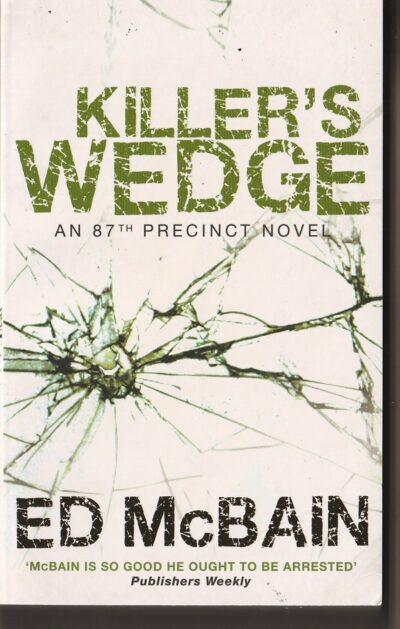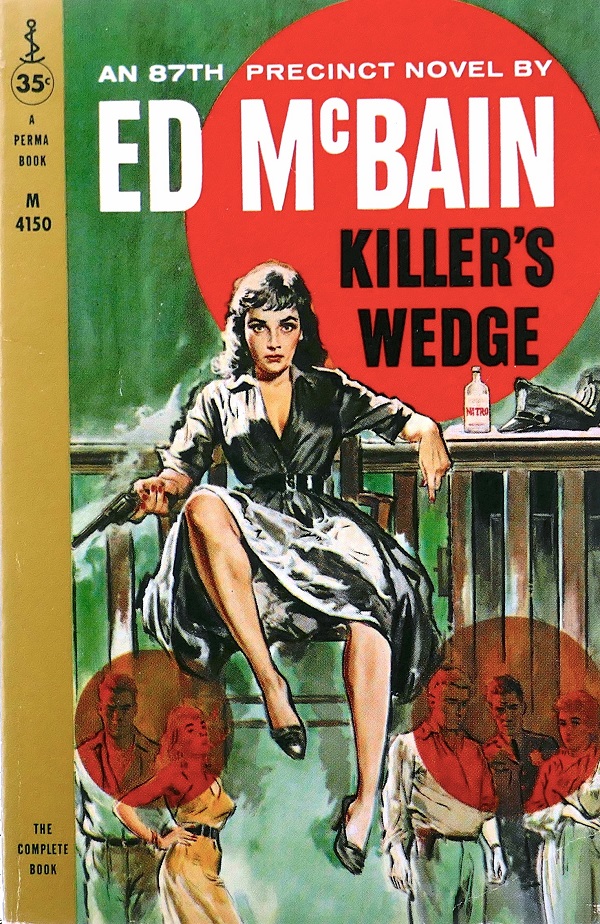Ed McBain’s 1954 novel Killer’s Wedge, the eighth book in his 87th Precinct series, opens with a short poetic rhapsody to autumn in the city:
Outside the grilled windows of the 87th’s squad room, Grover Park was aflame with color. Indian summer, like a Choctaw princess, strutted her feathers, wiggled her bright reds and oranges and yellows on the mild October air.
Inside the squad room, it was a normal weekday afternoon as three of the squad’s detectives handled calls and wrote reports and kibbitzed about love and hate.
 And then she walked in.
And then she walked in.
The woman who stood just outside the slatted rail divider which separated the squad room from the corridor had entered so silently that none of the men had heard her approach. She had just cleared her throat, and the sound was shockingly loud, so that Kling and Meyer turned to face her at almost the same moment Hawes did.
She looked for a moment like Death personified.
She had deep black hair pulled into a bun at the back of her head. She had brown eyes set in a face without make-up, without lipstick, a face so chalky white that it seemed she had just come from a sickbed somewhere.
She was there to see another detective, Steve Carella.
She was there to kill him.
A clear liquid
The woman — her name is Virginia Dodge, Mrs. Frank Dodge — takes over the squad room at this moment and takes over McBain’s novel.
She is carrying a .38 pistol, and, in her black bag, she has a small bottle filled with a clear liquid that she tells the men is nitroglycerine. They can’t be sure.
She certainly might have nitro since her husband was a safe-cracker, known to use the stuff, before he was sent away to prison for shooting and blinding a robbery victim.
He was arrested by Carella who, in the nature of things, went to court to testify against him.
Yesterday, in prison, Frank died. Now, his wife is here to kill Carella.
Claustrophobic intensity
From the fourth page of Killer’s Wedge, Viginia Dodge abducts the three squad room detectives and their lieutenant, all of whom give up their guns under her threat to shoot one of them or explode her nitro and take down the whole building. She abducts other cops who wander in and one of their arrestees and another civilian.
And she does shoot the gun, more than once, badly wounding one cop, and uses the weapon to pistol-whip another and slash the face of a third.
And the small bottle of clear liquid is always kept close at hand.
For 225 pages, she holds these cops at bay — and holds the reader enthralled — while she waits through the long afternoon hours until 6 pm when the cop she is waiting for is expected to return.
There is a claustrophobic intensity to Killer’s Wedge since almost all of the novel’s action takes place in this single, crowded room.
Throughout the afternoon and through all those pages, McBain notes the movement of the clock ever closer to the moment when Carella will walk in.
Virginia Dodge sits there, armed and ready for him.
A lighter melody
 Killer’s Wedge is a tour de force, as McBain makes clear that he can write suspense with the best of them.
Killer’s Wedge is a tour de force, as McBain makes clear that he can write suspense with the best of them.
And, like a great composer or movie director, he breaks the tension of those hours in the increasingly crowded (and increasingly hot) room by weaving in a lighter melody.
This melody has to do with another 87th Precinct detective who finds himself investigating , of all things, a locked-room death, as if he were Hercule Poirot in an Agatha Christie mystery.
It’s a delicious contrast to what’s happening back in the precinct — made even more delicious by the fact that the detective is Steve Carella.
He left a fortune
There was, of course, no such thing as a locked-door murder mystery.
Steve Carella knew that with the instinct of an inveterate murder mystery reader and a true cop.
And yet here he was investigating a suicide which had taken place in a windowless room and — to make matters worse — the victim appeared to have hanged himself after locking the door from the inside.
It had taken three very large, strong men — the three sons of the dead man — to bust in from the outside. So, it certainly looked like suicide, although the man had been very rich and had not left a note.
The trouble is these sons of his all look as if they are capable of tripping a blind woman and cutting out her heart. And the old man left a fortune to be divided among them.
Heads back to the squad room
Carella almost gets killed solving the case — and he does solve the case.
And he does head back to the squad room.
And, well, you’ll just have to read Killer’s Wedge to learn what happens in the book’s final pages.
Patrick T. Reardon
3.26.24
Written by : Patrick T. Reardon
For more than three decades Patrick T. Reardon was an urban affairs writer, a feature writer, a columnist, and an editor for the Chicago Tribune. In 2000 he was one of a team of 50 staff members who won a Pulitzer Prize for explanatory reporting. Now a freelance writer and poet, he has contributed chapters to several books and is the author of Faith Stripped to Its Essence. His website is https://patricktreardon.com/.
